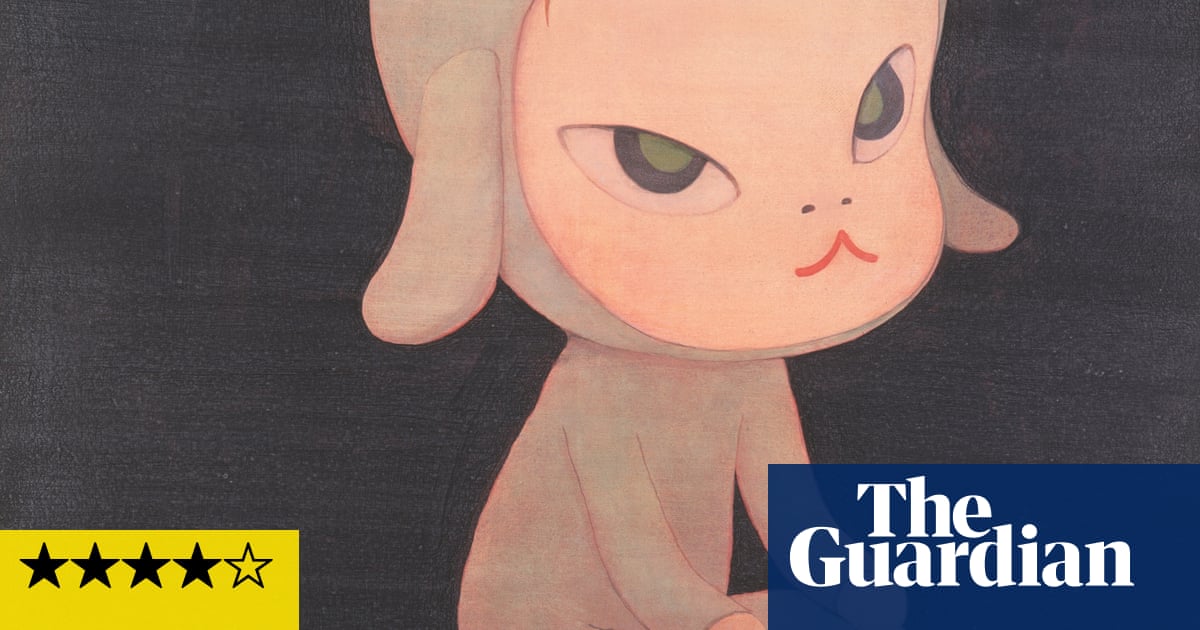There’s a video online of 100 kids playing footballagainst three adult pros. The kids get absolutely annihilated. But they’d do a whole lot better if they were more like the menacing, knife-wielding little terrors who populate Japanese artist Yoshitomo Nara’s world. Try dribbling past a toddler when he’s just jabbed a shiv in your calf, Lionel Messi.
For 40 years now Nara has been dealing in cutesy kitsch with a vicious edge. His paintings and drawings of adorably bug-eyed little nippers are singularly Nara: love it or hate it, he’s carved out his own instantly recognisable aesthetic path.
Me, I quite like it. It’s full of punk rock attitude, dark humour and comic book immediacy. This huge show at the Hayward kicks off with a ramshackle shed in the middle of the gallery, filled with empty beer cans, coffee cups and hundreds of drawings on paper and cardboard. A speaker blasts out rock’n’roll and folk classics by Nick Drake and David Bowie. A painting on the outside shows a blissed out little kid in a serene green field: “place like home”, it says in big bold all-caps. The huge wall opposite is lined with old prog and rock LPs.
This could’ve been the whole show and it would have been perfect; it’s everything Nara needs to say. Here in this little wooden shack sanctuary he loses himself in music and draws his heart out. The images all over the floor show punk-rocking kids blasting out chords on electric guitars, protesting against war and shooting pistols while standing on a snarling dog, yelling “I’m a son of a gun”.
It’s Nara summed up: a joyful mashup of music nerdery, political anxiety and the uncontrollable urge to draw, draw, draw. You get the sense that if his career had started and ended in this shack, no success, no big museum-style shows, just music and art, he’d have been pretty happy.
But this is a big show so there’s a lot more to get through. His early work is more expressionistic and dark, a little more scrawly and angry, like a pissed off Basquiat, or George Grosz drawing comics. But by the mid-90s he’d figured himself out and stripped everything back. His cartoon-y grumpy kids now sit against plain backgrounds, there’s nothing to distract you from them as symbols of Nara’s emotional states: boredom, anger, loneliness, sadness, frustration. That’s all that’s here, emotion pure and simple. A little girl with a bandaged face is livid about having the mumps, a figure (dressed as kitty) sitting on duck-shaped potty is seriously angry that you’re having a peek, and the world’s naughtiest child is grinning demonically after cutting a flower down with a saw, a big “fuck you” painted on the back of her jacket. It’s super-direct, simple, funny, emotional painting.
Nara repeats this approach over and over across the years. His figures burn down houses, swear, smoke, brandish weapons, play guitars. It’s the punk rebellion of youth continuing to find a voice. The kids resemble a take on forest sprites, little mythological figures used to tell stories, express emotions.
It’s not all angry self-reflection. More recent work finds Nara fighting for peace. One girl wears a “no war” T-shirt, another stands under a massive “stop the bombs” banner.
Things change in 2011, when the tragedy ofFukushimasends Nara spiralling. Now the kids are all hazy and heartbroken. They’re not ranting and raving any more, they just seem to haunt the canvases, barely there, sad and forlorn. I don’t think these are good paintings for the most part, despite being about something incredibly sad: they’re just too washed out and overthought, a bit mawkish and soft focus. And there’s something not quite right about giving these big canvases all this space, and these benches for you to contemplate them from, in a show that’s otherwise all chaos and energy.
I’m not totally convinced the work warrants this many rooms. It all gets a bit repetitive and stretched. And the ceramic heads dotted around the space, especially the tea cup fountain at the end, add absolutely nothing to the exhibition. But the best work here can be so joyful, approachable, angry and relatable that you can forgive these faults.
Nara is best when he’s being direct and immediate, when his art is about rocking out, fighting back and letting his heart spill on to the canvas. When he’s hey ho-ing and let’s going like his beloved Ramones. I’ve never encountered a show less in need of explanatory wall texts, or more resistant to artsy over-intellectualising: Nara tells you exactly what he feels, all the time. He just does it with the stereo blasting, and a knife behind his back.
At the Hayward Gallery, London, from 10 June to 31 August
